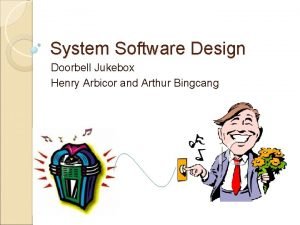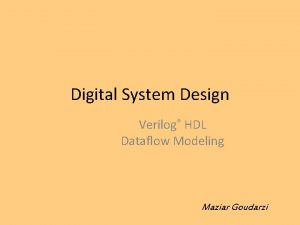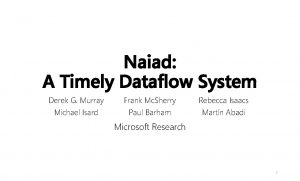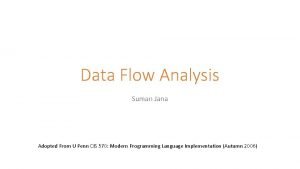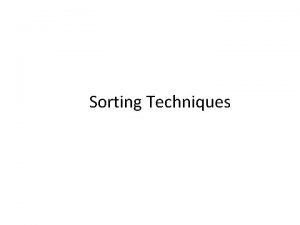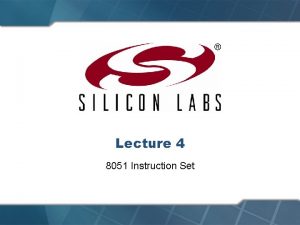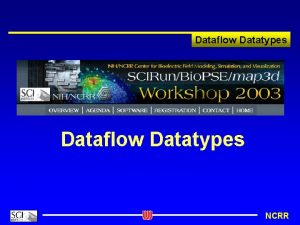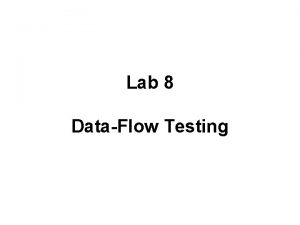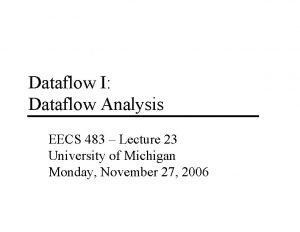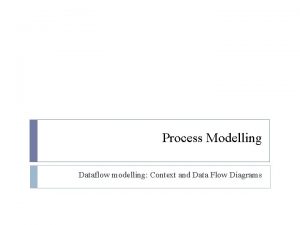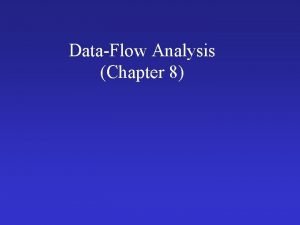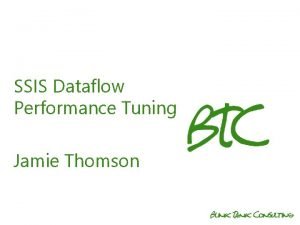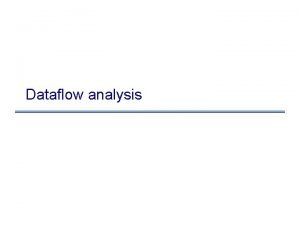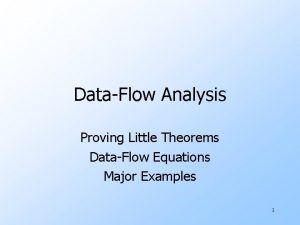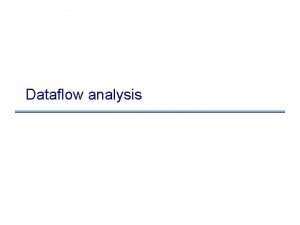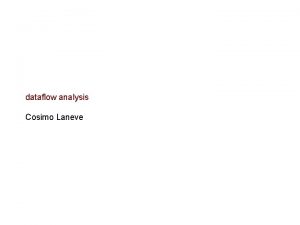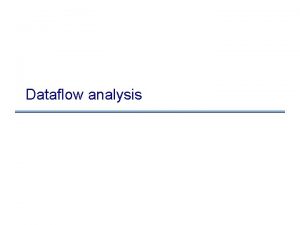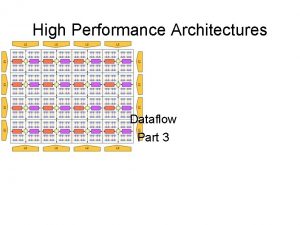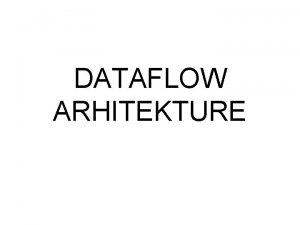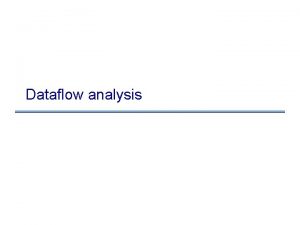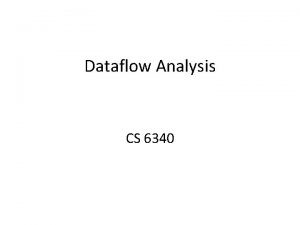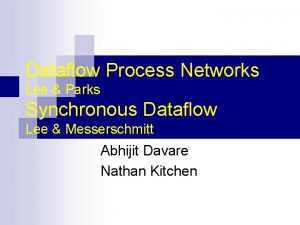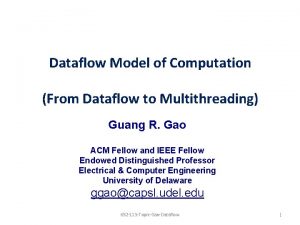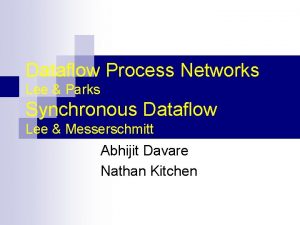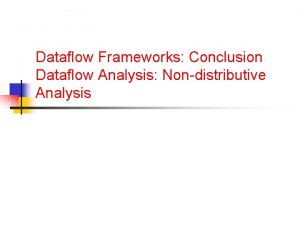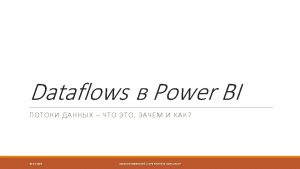Dataflow modelling Lecture 4 Dataflow modelling Specifies the






![Conditional signal assignment statement concurrent_signal_assignment: : = [POSTPONED] conditional_signal_assignment | [POSTPONED] selected_signal_assignment; conditional_signal_assignment: : Conditional signal assignment statement concurrent_signal_assignment: : = [POSTPONED] conditional_signal_assignment | [POSTPONED] selected_signal_assignment; conditional_signal_assignment: :](https://slidetodoc.com/presentation_image_h2/b76b86e4f865d4c4cbde15eaaeb1a985/image-7.jpg)


![Selected signal assignment selected_signal_assignment: : = WITH expression SELECT target <= [TRANSPORT|[REJECT time_expression]INERTIAL] selected_waveforms; Selected signal assignment selected_signal_assignment: : = WITH expression SELECT target <= [TRANSPORT|[REJECT time_expression]INERTIAL] selected_waveforms;](https://slidetodoc.com/presentation_image_h2/b76b86e4f865d4c4cbde15eaaeb1a985/image-10.jpg)






![BLOCK statement [Bha 95] • It is a concurrent statement • It can have BLOCK statement [Bha 95] • It is a concurrent statement • It can have](https://slidetodoc.com/presentation_image_h2/b76b86e4f865d4c4cbde15eaaeb1a985/image-17.jpg)
![BLOCK BNF description: Block_statement: : = Block_label: BLOCK [(guard_expression)][IS] [Block_header] [Block_declarative_part] BEGIN concurrent_statements END BLOCK BNF description: Block_statement: : = Block_label: BLOCK [(guard_expression)][IS] [Block_header] [Block_declarative_part] BEGIN concurrent_statements END](https://slidetodoc.com/presentation_image_h2/b76b86e4f865d4c4cbde15eaaeb1a985/image-18.jpg)









- Slides: 27

Dataflow modelling Lecture 4

Dataflow modelling • Specifies the functioning of a circuit without explicitly refer to its structure • Functioning is described by the flow of information through the circuit, using mostly concurrent signal assignment statements and BLOCK statements • Statements: – – Concurrent signal assignments Concurrent ASSERT statements Concurrent procedure calls BLOCK

Concurrent signal assignments • Concurrent signal assignments are triggered by events (they are event triggered), i. e. they execute when an event takes place for the expression that is assigned to the signal. • Sequential signal assignment execute when the statement is executed within the process => they are not triggered by the events from the expression that is assigned to the signal. Example: ARCHITECTURE sequential_assignment OF example IS SIGNAL a, b, z : some_type; BEGIN PROCESS(b) BEGIN a<=b; z<=a; END PROCESS; END ARCHITECTURE;

Concurrent signal assignments ARCHITECURE concurrent_assignment OF example IS SIGNAL a, b, z: some_type; BEGIN a<=b; z<=a; END ARCHITECTURE; First architecture (sequential_assignment): • When there is an event on b, the process will resume • Signal a is scheduled to take the new value of b; • Signal z is scheduled to take the value of a (which is the previous value of b).

Concurrent signal assignments Second architecture (concurrent_assignment): • If an event takes place on b at the moment Tc, then the statement a<=b is executed • Hence a is scheduled a new value at the moment Tc+Δ; • At Tc+ Δ an event takes place on a => the statement z<=a is executed; • At Tc+2 Δ signal z will receive the value of a, which is also the new value of b. Second architecture is equivalent with: PROCESS(b) BEGIN a<=b; END PROCESS; PROCESS(a) BEGIN z<=a; END PROCESS;

Concurrent signal assignments A concurrent statement like: s<=x+y+z; -- x, y, z, s signals Is equivalent with: PROCESS BEGIN s<=x+y+z; WAIT ON x, y, z; END PROCESS;
![Conditional signal assignment statement concurrentsignalassignment POSTPONED conditionalsignalassignment POSTPONED selectedsignalassignment conditionalsignalassignment Conditional signal assignment statement concurrent_signal_assignment: : = [POSTPONED] conditional_signal_assignment | [POSTPONED] selected_signal_assignment; conditional_signal_assignment: :](https://slidetodoc.com/presentation_image_h2/b76b86e4f865d4c4cbde15eaaeb1a985/image-7.jpg)
Conditional signal assignment statement concurrent_signal_assignment: : = [POSTPONED] conditional_signal_assignment | [POSTPONED] selected_signal_assignment; conditional_signal_assignment: : = target<= [TRANSPORT|[REJECT time_expression] INERTIAL] conditional_waveforms; conditional_waveforms: : = {waveform WHEN condition ELSE} [waveform WHEN condition] • Conditional signal assignment is executed every time when an event takes place on any one of the signals from the waveforms or from conditions. • Conditions are evaluated one by one, in the order in which they are written. • For the first condition found true, the target signal is assigned the waveform from that condition.

Conditional signal assignment statement: the equivalent process Example. In an architecture we have the statement: ARCHITECTURE ex OF ex IS BEGIN s<=x+y-2 AFTER 10 ns WHEN i 0=‘ 0’ AND i 1=‘ 0’ ELSE x-y+2 AFTER 10 ns WHEN i 0=‘ 1’ AND i 1=‘ 0’ ELSE x+y AFTER 7 ns WHEN i 0=‘ 0’ AND i 1=‘ 1’ ELSE x-y AFTER 5 ns; END ARCHITECUTE;

Conditional signal assignment statement: the equivalent process The statement is equivalent with the following process: PROCESS BEGIN IF i 0=‘ 0’ AND i 1=‘ 0’ THEN s<= x+y-2 AFTER 10 ns ; ELSIF i 0=‘ 1’ AND i 1=‘ 0’ THEN s<= x-y+2 AFTER 10 ns; ELSIF i 0=‘ 0’ AND i 1=‘ 0’ THEN s<=x+y AFTER 7 ns; ELSE s<=x-y AFTER 5 ns; END IF; WAIT ON i 0, i 1, x, y; END PROCESS;
![Selected signal assignment selectedsignalassignment WITH expression SELECT target TRANSPORTREJECT timeexpressionINERTIAL selectedwaveforms Selected signal assignment selected_signal_assignment: : = WITH expression SELECT target <= [TRANSPORT|[REJECT time_expression]INERTIAL] selected_waveforms;](https://slidetodoc.com/presentation_image_h2/b76b86e4f865d4c4cbde15eaaeb1a985/image-10.jpg)
Selected signal assignment selected_signal_assignment: : = WITH expression SELECT target <= [TRANSPORT|[REJECT time_expression]INERTIAL] selected_waveforms; Selected_waveforms: : = {waveform WHEN choices, } waveform WHEN choices: : = {choice, } choice: : =simple_expression | discrete_range | OTHERS • When an event takes place on any one of the signals from expression or from waveforms, the statement is executed, which means: • expression is evaluated • The target signal is assigned the waveform from the branch which contains the value of the expression. • Choices must be different and must cover all the values of the expression.

Selected signal assignment: the equivalent process The statement: WITH a+b SELECT s<= x+y WHEN 0|1|2, x-y AFTER 5 ns WHEN 3 TO 10, UNAFFECTED WHEN OTHERS; Is equivalent with: PROCESS BEGIN CASE a+b IS WHEN 0|1|2 => s<=x+y; WHEN 3 TO 10 => s<= x-y AFTER 5 ns; WHEN OHTERS=> NULL; END CASE; WAIT ON a, b, x, y; END PROCESS;

The UNAFFECTED value • There are situations when we want that the value of a signal will remain unchanged • This can be done using UNAFFECTED • Using UNAFECTED there will be no changes on the signal driver – If we write x <= x; there will be changes ! • Sequential equivalent for UNAFFECTEFD is the NULL statement;

Concurrent ASSERT statement • Has the same form like sequential ASSERT statement. • It is executed every time when there is an event on any of the signals from conditions. • Example: ASSERT s 1/=s 2 -- /= means different REPORT “error, s 1=s 2” SEVERITY ERROR; • The equivalent process: PROCESS BEGIN ASSERT s 1/=s 2 REPORT “eror, s 1=s 2” SEVERITY ERROR; WAIT ON s 1, s 2; END PROCESS;

Concurrent procedure calls • In VHDL there exist procedures and functions. – A FUNCTION returns one value – A PROCEDURE performs some computations • Function calls appear in expressions, hence they cannot be separate statements. • Procedure calls can be sequential or concurrent statements. • A concurrent procedure is equivalent with a process that contains – The sequential procedure call – And a WAIT statement containing in the sensitivity clause all signals that are parameters of mode IN or INOUT of that procedure • A concurrent procedure call does not allow the procedure to have parameters of class VARIABLE.

Concurrent procedure calls -- procedure declaration PROCEDURE compute(SIGNAL a, b: IN INTEGER; SIGNAL res: OUT INTEGER; SIGNAL x: INOUT INTEGER) BEGIN … END PROCEDURE; --a concurrent procedure call (inside an architecture): ARCHITECTURE call_proc OF ex IS SIGNAL siga, sigb, sigres, sigx: INTEGER; BEGIN … compute(siga, sigb, sigres, sigx); END ARCHITECTURE;

Concurrent procedure calls -- the equivalent process: ARCHITECTURE call_proc OF ex IS SIGNAL siga, sigb, sigres, sigx : INTEGER; PROCESS BEGIN compute(siga, sigb, sigres, sigx); WAIT ON siga, sigb, sigx; END PROCESS; END ARCHITECTUTRE;
![BLOCK statement Bha 95 It is a concurrent statement It can have BLOCK statement [Bha 95] • It is a concurrent statement • It can have](https://slidetodoc.com/presentation_image_h2/b76b86e4f865d4c4cbde15eaaeb1a985/image-17.jpg)
BLOCK statement [Bha 95] • It is a concurrent statement • It can have three utilizations: 1. to deactivate the driver of a signal (in guarded blocks) 2. To limit the visibility of some declarations (including signal declarations) 3. To partition a project in order to increase the clarity of the program: – E. g. we describe a microprocessor and we have the registers block, the ALU block, the control unit block, etc. ; in the registers block we can have a block for each register
![BLOCK BNF description Blockstatement Blocklabel BLOCK guardexpressionIS Blockheader Blockdeclarativepart BEGIN concurrentstatements END BLOCK BNF description: Block_statement: : = Block_label: BLOCK [(guard_expression)][IS] [Block_header] [Block_declarative_part] BEGIN concurrent_statements END](https://slidetodoc.com/presentation_image_h2/b76b86e4f865d4c4cbde15eaaeb1a985/image-18.jpg)
BLOCK BNF description: Block_statement: : = Block_label: BLOCK [(guard_expression)][IS] [Block_header] [Block_declarative_part] BEGIN concurrent_statements END BLOCK [Block_label];

BLOCK • Block_label –the label is mandatory. • Block_header – block header – If it exists, it describe the block interface with the outside word, i. e. ports and generics (like for components) – since blocks cannot be instantiated, the header is less useful like at components (used during the elaboration phase !!) • Block_declarative_part – Declarative part is optional – May contain declarations of: • Types, subtypes, constants, signals – MAY NOT contain: variable declarations – Anything declared in the declarative part of the block is visible only inside the block • The body of the block: between BEGIN and END BLOCK: – May contain any number of concurrent statements, including none – May conain other BLOCK statements, on any number of levels. • The label from the end of the block is optional but, if appears, it must be the same as the label from the beginning of the block. • The symbol ; at the end is mandatory

Blocks and guards Guard_expression: - • If the block contains a guard expression, then a signal named GUARD, of type BOOLEAN, will be implicitly declared. • The value of the signal GUARD is given by the guard expression, which hasto be of type BOOLEAN. • In the guard expression we can have signals, but not variables. • The value of the signal GUARD is updated when the guard value changes. • Signal assignment from inside the block can use the GUARD signal in order to activate / de-activate their drivers. • Example: b 1: BLOCK (strobe=‘ 1’) BEGIN z <= GUARDED NOT a; END BLOCK b 1;

Blocks and guards • The keyword GUARDED can be optionally used at concurrent signal assignments inside the block • In the previous example – The guard expression is (strobe=‘ 1’) – GUARD <= (strobe=‘ 1’); – When strobe is modified strobe, the GUARD signal will be modified as well – When the GUARD signal has the value TRUE, the signal z is assigned the expression (NOT a) – If GUARD is FALSE then the driver of z is de-activated, i. e. : • The events that appear on signal a do not affect the value of z • Signal z maintains its previous value.

Guarded signal assignment • It is the only statement whose semantics is affected by its presence inside a guarded block • Models sequential logic (hardware elements triggered by certain events) • Functioning of the statement: – Every time where an event takes place on any of the signals from the expression and if the guard has the value TRUE or ot changes its value from FALSE to TRUE, the guarded signal assignment statement will be executed (new values are scheduled to the target signal) – If the value of the guard signal is FALSE, then the driver of the target signal remains unchanged (the value of the target signal remains also unchanged)

The equivalent process bl: BLOCK (guard_expression) --SIGNAL GUARD: BOOLEAN; BEGIN sig<= GUARDED waveform_expression; END BLOCK b 1; Is equivalent with bl: BLOCK (guard_expression) --SIGNAL GUARD: BOOLEAN; BEGIN PROCESS BEGIN IF GUARD THEN sig<= waveform_expression; END IF; WAIT ON GUARD, signals_in_waveform_expression; END PROCESS; END BLOCK;

Other examples Signal GUARD, although not explicitly declared, can be used inside the block. Example: b 2: BLOCK (set=‘ 1’ AND reset=‘ 0’) BEGIN q<= ‘ 1’ WHEN GUARD ELSE ‘ 0’; END BLOCK b 2; The signal assignment statement is not guarder => the driver of signal q will never be deactivated.

Other examples In a block it is possible to declare explicitly a BOOLEAN signal named GUARD, to assign a logic expression to it and then to use it for guarded signal assignments inside the block. : B 3: BLOCK SIGNAL GUARD: BOOLEAN; BEGIN GUARD <= reset=‘ 0’ AND set=‘ 1’; q <= GUARDED d; END BLOCK;

Example of D flip-flop ENTITY dff IS PORT(clk, d: IN BIT; q, qbar : OUT BIT); END dff; ARCHITECTURE garda OF dff IS BEGIN B: BLOCK(clk=‘ 1’ AND NOT clk’STABLE) -- had the guard been (clk=‘ 1’), D would have been level-- triggered (i. e. , a latch), now is edge-triggered (flip-flop) SIGNAL temp: BIT; BEGIN temp<=GUARDED d; q<=temp; qbar<=NOT temp; END BLOCK; END ARCHITECTURE; • signal temp is visible only inside the block • clk’STABLE is a BOOLEAN signal which is TRUE if clk did not have any events in the current simulation cycle

Example of visibility limitation ARCHITECTURE ex OF ex IS SIGNAL s 1, s 2: INTEGER; BEGIN b 1: BLOCK SIGNAL s 3, s 4: INTEGER; BEGIN b 2: BLOCK SIGNAL s 1, s 4, s 5: INTEGER; -- s 1 and s 4 -- overwritten BEGIN s 4<=. . . – refers to s 4 from the block b 2 b 1. s 4 <=. . . —in order to refer to s 4 from b 1 END BLOCK b 2; END BLOCK b 1; END ARCHITECTURE;
 01:640:244 lecture notes - lecture 15: plat, idah, farad
01:640:244 lecture notes - lecture 15: plat, idah, farad Dataflow mmc
Dataflow mmc Dataflow verilog
Dataflow verilog Structural vs dataflow verilog
Structural vs dataflow verilog Timely dataflow
Timely dataflow Dr suman jana
Dr suman jana Coordinates that specifies the north-south position.
Coordinates that specifies the north-south position. Route sheet specifies
Route sheet specifies Sorting algorithm specifies the way to
Sorting algorithm specifies the way to Organizational structure specifies the firm's:
Organizational structure specifies the firm's: What specifies the headings paragraphs images
What specifies the headings paragraphs images Cpl specifies privilege level of
Cpl specifies privilege level of Ajmp instruction in 8051 example
Ajmp instruction in 8051 example Lp html
Lp html Thế nào là giọng cùng tên? *
Thế nào là giọng cùng tên? * Làm thế nào để 102-1=99
Làm thế nào để 102-1=99 Hát lên người ơi
Hát lên người ơi Sự nuôi và dạy con của hổ
Sự nuôi và dạy con của hổ đại từ thay thế
đại từ thay thế Vẽ hình chiếu vuông góc của vật thể sau
Vẽ hình chiếu vuông góc của vật thể sau Công của trọng lực
Công của trọng lực Tỉ lệ cơ thể trẻ em
Tỉ lệ cơ thể trẻ em Thế nào là mạng điện lắp đặt kiểu nổi
Thế nào là mạng điện lắp đặt kiểu nổi Dạng đột biến một nhiễm là
Dạng đột biến một nhiễm là Lời thề hippocrates
Lời thề hippocrates Vẽ hình chiếu đứng bằng cạnh của vật thể
Vẽ hình chiếu đứng bằng cạnh của vật thể Phản ứng thế ankan
Phản ứng thế ankan Quá trình desamine hóa có thể tạo ra
Quá trình desamine hóa có thể tạo ra

